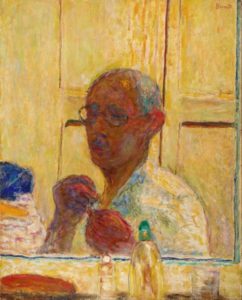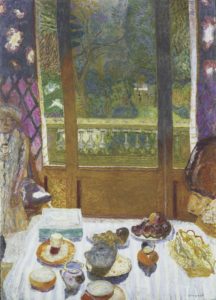To eyes accustomed to impressionism, the work of Pierre Bonnard can at first seem incredibly indulgent, as if he missed the point of the system. He had the impressionist love of light and vibratory color effects, but instead of the clear sparkling landscapes of his predecessors, Bonnard presents us with a flat-patterned world of strange, often arbitrary colors, in which every passage seems to vie with the others for our attention.

It is for this reason that Bonnard has often been called a hedonistic painter, a “happy” artist, too concerned with prettiness for its own sake. But the longer one looks at his paintings, the more another mood comes out, a mood of reflection, solitude, and even melancholy, and a sense of painting as this process of looking long and deeply at things.
Bonnard died in 1947, having survived the German occupation of France, but missing the big 1948 retrospective at the Museum of Modern Art. A second show was held at MoMA in 1964. Now, the museum is host to a third, a show organized in collaboration with the Tate Gallery in London. Comprising some 80 works, “Bonnard” focuses on the artist’s foremost period of innovation, beginning in the mid-1910s, and leaves behind his early days in Paris when his work – mostly in prints – had a largely decorative thrust.
The world he creates in his paintings seems an intensely private one, drawn from a life that never strays far from the house or the garden, and yet, seems to provide him with endless inspiration.

“The Breakfast Room.”
His wife, Marthe, who for many years suffered from poor health and was given to long soaks in the tub, is the subject of many paintings. The early ones are often erotic, with Marthe pulling on black stockings or raising her chemise over her head. The later bathtub paintings have a kind of monumentality about them – the female form encapsulated by the tub, like Venus on her shell.
But it is less the forms than the way Bonnard painted things that constantly surprises us. His compositions are anchored with strong horizontals and verticals; and, within this grid he plays with patterns, creating a multitude of detailed passages, as rich as a tapestry.
Often, in fact, what might seem the important thing in the painting, such as a human figure, is relegated to the edges of the picture, then camouflaged with background color so that it often takes a moment to see that, yes, there is a face there, or someone bending over a table. He was determined to shake off the old system of figure-ground, in which certain elements are made to stand out against a blurred or toned-down background.
It often gives his paintings a comic quality. In “Nude in the Bath,” for example, a pair of legs in a bathtub stick out from the right-hand corner. The tub is tilted up to give us a view into it, but it and the body are rendered in such pale, pink and violet tones that our eyes skip over it at first. Instead, we find outselves contemplating the clothing draped on the chair in the background, the shimmering white of the translucent curtain, and the bold, Oriental carpet on the floor. Last, we see the leg, foot, and hand of a robed figure stepping in from the left, the artist himself, apparently, sketchbook in hand.
It’s such an odd painting, though the precedent for this kind of abrupt cropping had been used by the impressionists, who got it from Japanese prints, so it wasn’t new. But, combined with the spatial liberties, it contributes to a playfulness that is unusual in serious painting.
Also contributing to a sense of casualness in Bonnard’s art was his tendency not to fuss with the details of individual objects. It does us no good to get close to the canvas to better study a teapot or a fruit bowl. It turns out to be mere blobs of color. Bonnard’s art depends less on drawing than on getting the right color, tone, and general shape in the right place. And his canvases tell us repeatedly – step back.
Not all of Bonnard’s contemporaries were convinced of his greatness. Matisse, also given to decorative and playful patterning, was an admirer, but Picasso couldn’t stand his work. He had no patience for Bonnard’s tentative, hesitant brushstrokes, and his way of letting his paintings build up by gradual accretion.
But this sense of hesitancy, of uncertainty, is something that grows on us with Bonnard. We begin to feel it as a searching, a tendency to dwell thoughtfully, almost neurotically on things, not unlike his contemporary, Proust, who could devote 75 pages to a description of going to bed.
It can take a while to appreciate Bonnard’s emotional pitch, the playfulness, the excess, the leveling of people and objects. But he was something of a modern-day Vermeer, an artist who could find poetry in the mundane and who could make an ordinary room with an open window seem to contain all the beauty in the world.

